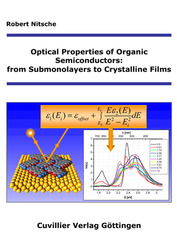| Departments | |
|---|---|
| Book Series (96) |
1379
|
| Nachhaltigkeit |
3
|
| Gesundheitswesen |
1
|
| Humanities |
2367
|
| Natural Sciences |
5407
|
| Mathematics | 229 |
| Informatics | 319 |
| Physics | 980 |
| Chemistry | 1364 |
| Geosciences | 131 |
| Human medicine | 243 |
| Stomatology | 10 |
| Veterinary medicine | 108 |
| Pharmacy | 147 |
| Biology | 835 |
| Biochemistry, molecular biology, gene technology | 121 |
| Biophysics | 25 |
| Domestic and nutritional science | 45 |
| Agricultural science | 1004 |
| Forest science | 201 |
| Horticultural science | 20 |
| Environmental research, ecology and landscape conservation | 148 |
| Engineering |
1793
|
| Common |
98
|
|
Leitlinien Unfallchirurgie
5. Auflage bestellen |
|
Advanced Search
Optical properties of organic semiconductors: From (sub-)monolayers to crystalline films (English shop)
Robert Nitsche (Author)Preview
Table of Contents, Datei (42 KB)
Extract, Datei (230 KB)
We have measured the optical properties of films of the organic semiconductors PTCDA and HBC, prepared by Organic Molecular Beam Expitaxy (OMBE), on different substrates by means of Differential Reflectance Spectroscopy (DRS). The optical setup used 51 allows to characterize the samples in situ and during the film growth. This enables us to directly follow the thickness dependent optical properties of the organic films, starting from submonolayer coverage up to thicker films on the order of 20 monolayers (ML) film thickness. However, due to the different optical nature of the different substrates used, i.e., mica, glass, Au(111), and HOPG, the DRS signal can not directly be interpreted in terms of the absorption of the films. Rather, the optical constants n (index of refraction) and k (absorption index) of the organic films have to be calculated to be able to discuss the spectral absorption of the films. We have proposed a method by which the calculation of the optical constants of thin films on arbitrary substrates from just one spectral measurement (in our case the DRS) becomes possible. The results fulfill a priori a Kramers-Kronig consistency, characteristic for physically meaningful values of the optical constants, and no specific model is needed to express the spectral behavior of the optical constants. Still, the requirement that the absorption index has to approach zero sufficiently at the measurement intervals restricts the application of our method to a class of materials, which exhibit distinct and well-separated absorption bands, like e.g. organic semiconductors. By means of appropriate extrapolation procedures, the method is able to account for small non-zero values of the absorption index at the boundaries of the measurement interval. Although we exclusively discussed the application of our method to differential reflectance spectra, it is anticipated that it works for all other optical quantities likewise.
| ISBN-13 (Printausgabe) | 3865378552 |
| ISBN-13 (Hard Copy) | 9783865378552 |
| ISBN-13 (eBook) | 9783736918559 |
| Language | English |
| Page Number | 178 |
| Edition | 1 |
| Volume | 0 |
| Publication Place | Göttingen |
| Place of Dissertation | Dresden |
| Publication Date | 2006-05-10 |
| General Categorization | Dissertation |
| Departments |
Physics
|








